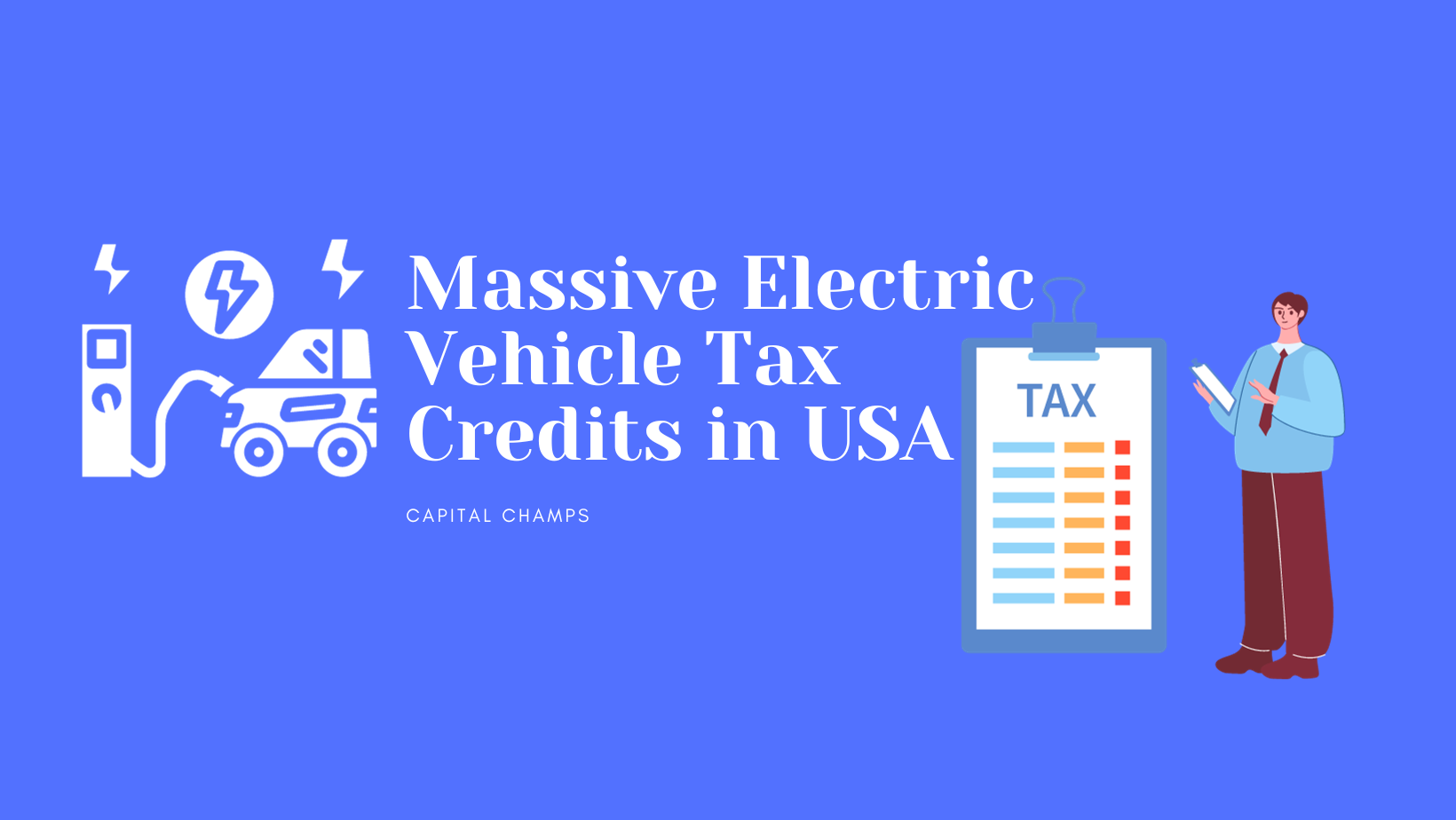Have you been tempted by the savings potential of electric vehicles but held back by steep sticker prices? Well, between state and federal incentives, going electric could cost way less than you imagine! This comprehensive guide explores massive electric vehicle tax credits in USA. Read on to discover if your new or used EV purchase qualifies!
Introduction
The revolution urging automobile electrification and phasing out emission-spewing clunkers is well underway. Recognizing adoption barriers like limited model availability and sticker shocks, government tax credits cushion buyers financially. We will unpack federal incentives, processes and fine prints in this EV tax credit handbook. Are you ready to drive green and save green?
Overview of Federal EV Tax Credits
The US federal government offers personal and business income tax credits up to $7,500 for buying new zero-emission plug-in hybrid, battery electric and hydrogen fuel cell vehicles. Those acquiring used EVs since 2023 also recently gained eligibility for credits of $4,000 maximum.
Why Incentivize Cleaner Transportation?
such credits align citizen transportation priorities with larger environmental goals. As accretion incentives, they scale EV demand, enhancing affordability and technology improvements through economies of scale. Tax credits also accelerate emissions reduction from the transportation sector.
Brand New EV – Post 2023 Purchases
If you are shopping for a never-driven electric vehicle fresh off the production line, newly revised federal incentives await post-December 2022!
Eligibility Criteria

To qualify, besides final assembly in North America, new EV acquisitions from 2023 must also meet:
Critical mineral and battery parts sourcing norms: Variables dictate the credit amount – $7,500 for fully compliant models while partial compliance nets $3,750.
MSRP thresholds: Base MSRP cannot exceed $80,000 for trucks/vans and $55,000 for other body styles
Refer dealers for specifics on individual models. Your EV must tick all boxes for maximum savings!
Claiming Process
- Submit Form 8936 with your annual tax returns detailing vehicle information like VIN.
- The credit applies for the tax year when you took delivery and reduces owed taxes directly.
- No separate application necessary! Dealers handle reporting acquisition specifics to the IRS.
So new EV buyers simply claim formulized credits post-tax filing!
Used EVs – Purchased Post-2022
If pre-owned models better suit budgets, used EV purchases too now qualify for tax savings up to $4,000!
Eligibility Rules
Qualifying used EV criteria include:
- Sale by licensed dealers below $25,000
- 2+ year old models – e.g. 2021MY cars qualify in 2023
- GVW rating under 14,000 pounds
- Minimum 7 kWh battery pack
Certified used EV dealers must furnish mandated buyer/sale information to the IRS for the credit validity. So opt for reputable dealers when shopping!
Claiming Method
Submit the Form 8936 with tax returns post-acquisition, adding the 17-digit VIN. The non-refundable amount directly saves on tax dues.
Hence the used EV tax credit mechanism resembles new purchases!
New EVs – Pre 2023 Acquisitions
For those who adopted zero-emission mobility earlier, incentives still exist! However, criteria and limits differ.
Recap of Rules
The now-expired $7,500 tax credit on pre-2023 EV buys depended on:
- Battery size dictating capability recharges from external electricity
- GVW rating cut-off at 14,000 pounds
- Original leasing/ownership solely for personal use
- Purchase from recognized manufacturers
Claiming Procedure
The process matches 2023 purchases! Taxpayers submit the Form 8936 enclosing vehicle-specific details like VIN post-acquisition. Credits then directly offset tax liabilities.
Common EV Incentive Qualification Aspects
Some basic requirements stay consistent across new, used and previous EV incentives for clarity.
Shared Must-Haves
Universal prerequisites include:
Battery Capacity– All vehicles must boast at least 7 kWh battery packs allowing sufficient electrical energy storage for hybrid or pure electric mobility.
Gross Vehicle Weight – Federal tax credits only apply for cars or trucks under 14,000 pounds allowing their registration and legal street-use.
Qualified Manufacturers – Only recognized auto brands manufacturing highway-operational EVs qualify currently. This filters risky new players lacking credentials. However, fuel cell EVs escape this requirement.
So regardless of model year, these essential criteria form the foundation upholding federal tax credit eligibility!
Submitting and Tracking Credit Claims
Wondering how to navigate the application process to unlock tax savings on your EV? Here is a step-by-step walkthrough!
Claim Filing Protocol
Follow this roadmap to submit your claim correctly:
1. Acquire Form 8936 from the IRS website
2. Fill vehicle particulars like VIN accurately after purchase
3. Attach the form to your tax returns for the acquisition year
4. The applicable non-refundable amount reflects as tax credit directly on tax dues owed
Individuals vs Businesses
Individuals simply adjust the Form 8936 tax credit on their IRS Form 1040 for the filing year.
Whereas businesses record credits on Form 3800 while reporting income.
Either way, Form 8936 becomes the fulcrum channeling EV credits for both categories.
Looming Phase Out of Federal Credits
While welcoming EV adoption news,Credits reduce once an automaker sells over 200,000 qualifying vehicles cumulative from 2010 as per current rules.
Gradual Phase Down
Post the 200,000 sales threshold, federal tax credits decrease by:
- 50% for the next 2 quarters
- 25% for successive 2 quarters
Before complete phase out subsequently.
For example, Tesla and GM already underwent phase-outs hitting the ceiling sales milestone first. So their new buyers enjoy incentives no longer.
Industry and Consumer Implications
Analytics suggest most automakers will reach ceilings over 2023-2025, winding down incentives. This may slow adoption for brands adjusting slowly towards mass-market EV capabilities today. However, the widening accessible price spectrum still leaves ample choice for deal-seekers.
Auto Dealers – Spearheading Claims from 2024

So far individuals bore documentation responsibility to unlock federal tax savings from 2024. But proposed rules allow empowered dealers to pre-file claims facilitating quicker buyer access to incentives!
Overview of Upcoming Regulations
- Dealers can determine likely credit amounts for EV purchases using IRS interface and initiate claims
- Buyers then only review pre-validated documentation for accuracy
- The pre-submission process intends faster incentive availability
Dealer Duties
- Establish income tax credit estimate at sale using IRS portal
- Furnish necessary acquisition information like VINs etc.
- Share documentation with buyers early for efficient filing
Thus dealers upgrade to tax consultants smoothing purchase discounting!
Modified Incomes – The Fine Print
Another ubiquitous clause on federal EV tax credits relates to income levels although unused credits roll over provided vehicles stick to norms.
Applicable Income Ranges
To qualify, annual income must fall under:
- $300,000 for joint tax filers
- $225,000 for heads of households
- $150,000 for others
Either of the 2 preceding years with lower earnings works when calculating allowable limits.
Usage and Ownership
Home use acquisition bars later resale of vehicles. Additionally, buyers cannot claim dependents on tax returns and must principally operate cars in the US to qualify incentives.
The Road Ahead
While many automakers approach federal subsidy limits, recent policy innovations promise more affordable clean transit options still through consumer tax credits or alternate aids like subsidies encouraging domestic manufacturing.
Bidirectional Credits
Proposed bipartisan bills seek to make credits transferable between dealers and buyers during sales. Dealers then recoup amounts from IRS later. This empowers upfront point-of-sale savings on EVs rather than delayed claims.
Boosting Adoption by Low-Moderate Income Households
Separate suggestions also aim to spur EV purchases specifically by lower-middle income groups through augmented incentives like cash vouchers. Some states already fund income-linked EV buyer programs recognizing affordability barriers these sections face.
The motive remains clear – incentivize emissions-free mobility for all using every policy tool available!
Conclusion
I hope this electric vehicle tax credit guide offered clarity regarding applicable federal incentives, qualifying criteria, claiming processes and recent updates like used EV discounts. Check state programmes too for localized savings avenues when aggregating rewards.
As globally committed deadlines to combat climate change near, green transportation becomes pivotal. Seize propitious federal tax incentives before expiration to contribute your bit while saving money! Together, such climate-positive actions cumulatively impact our collective sustainable future. Read our article on Canada incentives on Electric vehicles.



